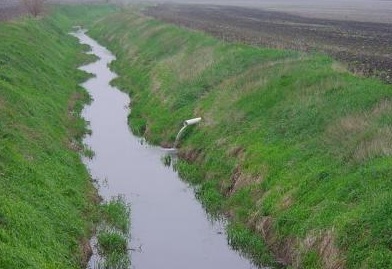
 September 29, 2010 – Tile
September 29, 2010 – Tile
drainage in the Mississippi Basin is one of the great advances of the 19th and
20th centuries, allowing highly productive agriculture in what was once land
too wet to farm. In fact, installation of new tile systems continues every
year, because it leads to increased crop yields. But a recent study shows that
the most heavily tile-drained areas of North America are also the largest
contributing source of nitrate to the Gulf of Mexico, leading to seasonal
hypoxia. In the summer of 2010 this dead zone in the gulf spanned over 7,000
square miles.
September 29, 2010 – Tile
drainage in the Mississippi Basin is one of the great advances of the 19th and
20th centuries, allowing highly productive agriculture in what was once land
too wet to farm. In fact, installation of new tile systems continues every
year, because it leads to increased crop yields. But a recent study shows that
the most heavily tile-drained areas of North America are also the largest
contributing source of nitrate to the Gulf of Mexico, leading to seasonal
hypoxia. In the summer of 2010 this dead zone in the gulf spanned over 7,000
square miles.
Scientists from the
University of Illinois and Cornell University compiled information on each
county in the Mississippi River basin – including crop acreage and yields,
fertilizer inputs, atmospheric deposition, number of people, and livestock – to
calculate all nitrogen inputs and outputs from 1997 to 2006. For 153 watersheds
in the basin, they also used measurements of nitrate concentration and flow in
streams, which allowed them to develop a statistical model that explained 83
percent of the variation in springtime nitrate flow in the monitored streams.
The greatest nitrate loss to streams corresponded to the highly productive,
tile-drained corn-belt from southwest Minnesota across Iowa, Illinois, Indiana,
and Ohio.
 |
|
This area of the basin has
extensive row cropping of fertilized corn and soybeans, a flat landscape with
tile drainage, and channeled ditches and streams to facilitate drainage.
“Farmers are not to
blame,” said University of Illinois researcher Mark David. “They are using the
same amount of nitrogen as they were 30 years ago and getting much higher corn
yields, but we have created a very leaky agricultural system. This allows nitrate
to move quickly from fields into ditches and on to the Gulf of Mexico. We need
policies that reward farmers to help correct the problem.”
David is a biogeochemist
who has been studying the issue since 1993.
“We’ve had data from
smaller watersheds for some time, but this new study includes data from the
entire Mississippi Basin. It shows clearly where across the entire basin the
sources of nitrate are.
“A lot of people just want
to blame fertilizer, but it’s not that simple,” David said. “It’s fertilizer on
intensive corn and soybean agricultural rotations in heavily tile-drained
areas. There is also an additional source of nitrogen from sewage effluent from
people, although that is a small contribution. It’s all of these factors
together.”
David said that ripping
out all of the drainage tiles is not a viable option.
“Creating wetlands and
reservoirs such as Lake Shelbyville can remove nitrate by holding the water
back and letting natural processes remove it, but that’s not a solution. It’s
expensive and we can’t flood everyone’s land to stop nitrate. That’s not going
to happen.
“The problem is
correctable but will take a concerted effort to change the outcome, with some
of the solutions expensive. Installing small wetlands or bioreactors at the end
of tile lines that remove nitrates before they flow into the ditch do work, but
would cost thousands of dollars per drain. Who’s going to pay for that?” David
asked.
Cover crops can hold the
nutrients so they are available in the spring, and are reasonably cheap, David
said, but can increase the farmer’s risk for the following crop.
“So if a farmer plants a
cover crop and his neighbor doesn’t, he may be at a disadvantage.”
David believes that the
system can be improved by focusing conservation efforts on the areas of the
country that are contributing the most nitrate loss and establish an incentive
program for farmers to utilize one or more practices known to reduce nitrate
losses from tile lines.
Encouraging farmers to
apply the right amount of nitrogen in the spring rather than the fall (or to
side dress), establishing a more complex cropping system which incorporates
cover crops or even biofuel crops, such as Miscanthus or switch grass, when
there are markets, and installing end-of-pipe solutions, such as controlled
drainage, bioreactors, or wetlands are some of the efforts David suggests would
help reduce nitrate loss.
“Until we change the
payment system beyond our focus on yield alone, we’re not going to make much
progress in reducing nitrate losses. We also haven’t developed voluntary
programs that really address nitrate loss from tiles, and we need to provide
more incentive and cost-share funding to producers. We may also need
regulation. We could say to producers, if you buy fertilizer, you’ve got to do
one of these five things,” he said. “There’s no one solution.”
“Dr. David’s work is an
important contribution in helping producers and policy makers identify the most
critical areas,” said Dennis McKenna of the Illinois Department of Agriculture.
“Hopefully this information will be used to develop a focused national and
state effort to reduce nutrient losses to surface water.”
Sources of Nitrate Yields
in the Mississippi River Basin was published in the September-October 2010
issue of the Journal of Environmental Quality.
Authors in addition to
David were Greg McIsaac from the University of Illinois and Laurie Drinkwater
from Cornell University.